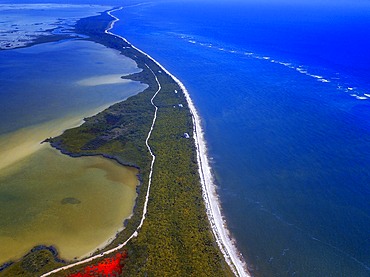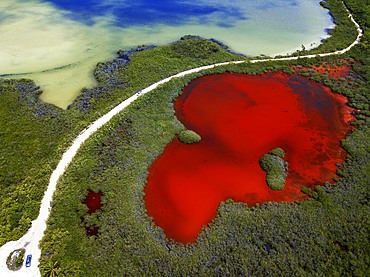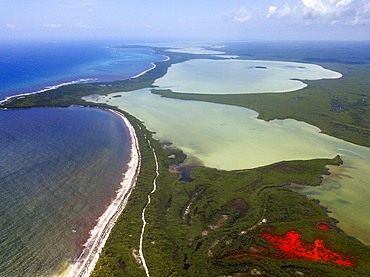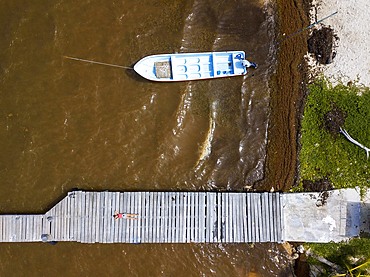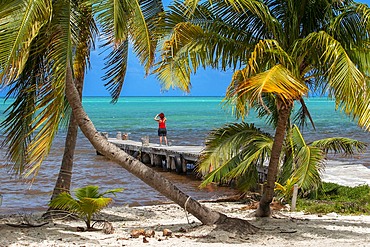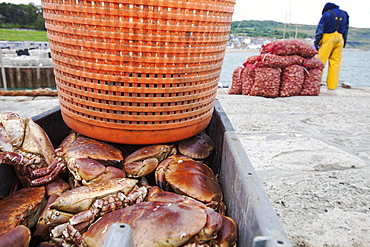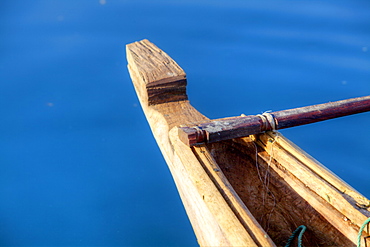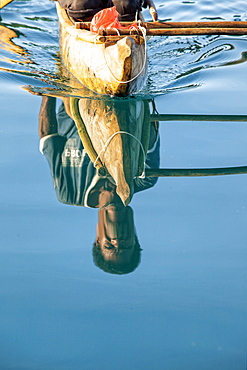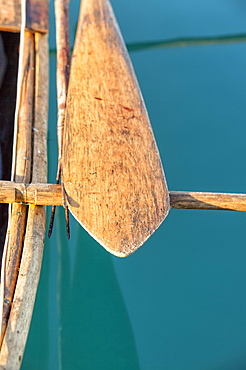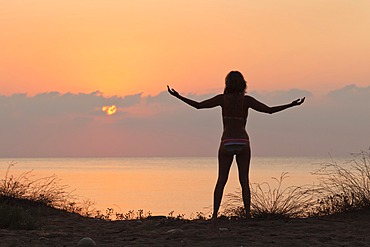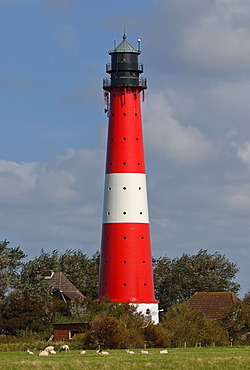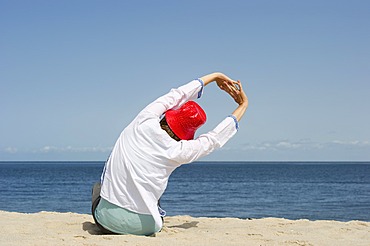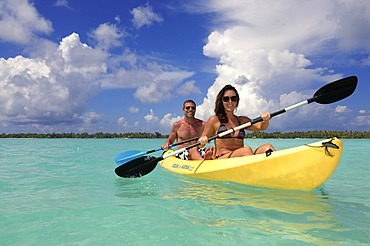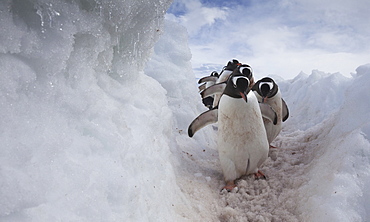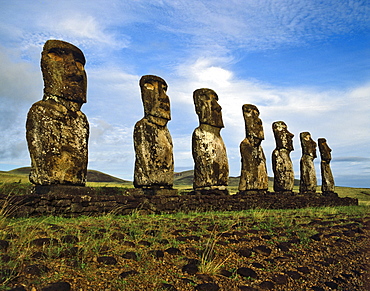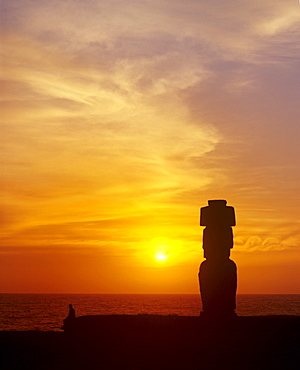Recent searches
Loading...
832-402268 - Foiling kiteboarding kitesurfing kiteboarder (kitesurfer) silhouette in the Atlantic ocean on sunset. Fonte da Telha beach, Costa da Caparica, Portugal, Europe
1350-6627 - Aerial view of Punta Allen Sian Ka'an Reserve, Yucatan Peninsula, Mexico. Red lagoon near Boca Paila Bridge.
In the language of the Mayan peoples who once inhabited this region, Sian Ka'an means Origin of the Sky. Located on the east coast of the Yucatán peninsula, this biosphere reserve contains tropical forests, mangroves and marshes, as well as a large marine section intersected by a barrier reef. It provides a habitat for a remarkably rich flora and a fauna comprising more than 300 species of birds, as well as a large number of the region's characteristic terrestrial vertebrates, which cohabit in the diverse environment formed by its complex hydrological system.
Along its roughly 120 kilometres of coastline, the property covers over 400,000 hectares of land ranging from sea level to only ten m.a.s.l. The property boasts diverse tropical forests, palm savannah, one of the most pristine wetlands in the region, lagoons, extensive mangrove stands, as well as sandy beaches and dunes. The 120,000 hectares of marine area protect a valuable part of the Mesoamerican Barrier Reef and seagrass beds in the shallow bays. The lush green of the forests and the many shades of blue of the lagoons and the Caribbean Sea under a wide sky offer fascinating visual impressions.
1350-6623 - Aerial view of Punta Allen Sian Ka'an Reserve, Yucatan Peninsula, Mexico. Red lagoon near Boca Paila Bridge.
In the language of the Mayan peoples who once inhabited this region, Sian Ka'an means Origin of the Sky. Located on the east coast of the Yucatán peninsula, this biosphere reserve contains tropical forests, mangroves and marshes, as well as a large marine section intersected by a barrier reef. It provides a habitat for a remarkably rich flora and a fauna comprising more than 300 species of birds, as well as a large number of the region's characteristic terrestrial vertebrates, which cohabit in the diverse environment formed by its complex hydrological system.
Along its roughly 120 kilometres of coastline, the property covers over 400,000 hectares of land ranging from sea level to only ten m.a.s.l. The property boasts diverse tropical forests, palm savannah, one of the most pristine wetlands in the region, lagoons, extensive mangrove stands, as well as sandy beaches and dunes. The 120,000 hectares of marine area protect a valuable part of the Mesoamerican Barrier Reef and seagrass beds in the shallow bays. The lush green of the forests and the many shades of blue of the lagoons and the Caribbean Sea under a wide sky offer fascinating visual impressions.
1350-6625 - Aerial view of Punta Allen Sian Ka'an Reserve, Yucatan Peninsula, Mexico. Red lagoon near Boca Paila Bridge.
In the language of the Mayan peoples who once inhabited this region, Sian Ka'an means Origin of the Sky. Located on the east coast of the Yucatán peninsula, this biosphere reserve contains tropical forests, mangroves and marshes, as well as a large marine section intersected by a barrier reef. It provides a habitat for a remarkably rich flora and a fauna comprising more than 300 species of birds, as well as a large number of the region's characteristic terrestrial vertebrates, which cohabit in the diverse environment formed by its complex hydrological system.
Along its roughly 120 kilometres of coastline, the property covers over 400,000 hectares of land ranging from sea level to only ten m.a.s.l. The property boasts diverse tropical forests, palm savannah, one of the most pristine wetlands in the region, lagoons, extensive mangrove stands, as well as sandy beaches and dunes. The 120,000 hectares of marine area protect a valuable part of the Mesoamerican Barrier Reef and seagrass beds in the shallow bays. The lush green of the forests and the many shades of blue of the lagoons and the Caribbean Sea under a wide sky offer fascinating visual impressions.
1350-6620 - Aerial view of Punta Allen Sian Ka'an Reserve, Yucatan Peninsula, Mexico. Red lagoon near Boca Paila Bridge.
In the language of the Mayan peoples who once inhabited this region, Sian Ka'an means Origin of the Sky. Located on the east coast of the Yucatán peninsula, this biosphere reserve contains tropical forests, mangroves and marshes, as well as a large marine section intersected by a barrier reef. It provides a habitat for a remarkably rich flora and a fauna comprising more than 300 species of birds, as well as a large number of the region's characteristic terrestrial vertebrates, which cohabit in the diverse environment formed by its complex hydrological system.
Along its roughly 120 kilometres of coastline, the property covers over 400,000 hectares of land ranging from sea level to only ten m.a.s.l. The property boasts diverse tropical forests, palm savannah, one of the most pristine wetlands in the region, lagoons, extensive mangrove stands, as well as sandy beaches and dunes. The 120,000 hectares of marine area protect a valuable part of the Mesoamerican Barrier Reef and seagrass beds in the shallow bays. The lush green of the forests and the many shades of blue of the lagoons and the Caribbean Sea under a wide sky offer fascinating visual impressions.
1350-6616 - Aerial view of Punta Allen Sian Ka'an Reserve, Yucatan Peninsula, Mexico.
In the language of the Mayan peoples who once inhabited this region, Sian Ka'an means Origin of the Sky. Located on the east coast of the Yucatán peninsula, this biosphere reserve contains tropical forests, mangroves and marshes, as well as a large marine section intersected by a barrier reef. It provides a habitat for a remarkably rich flora and a fauna comprising more than 300 species of birds, as well as a large number of the region's characteristic terrestrial vertebrates, which cohabit in the diverse environment formed by its complex hydrological system.
Along its roughly 120 kilometres of coastline, the property covers over 400,000 hectares of land ranging from sea level to only ten m.a.s.l. The property boasts diverse tropical forests, palm savannah, one of the most pristine wetlands in the region, lagoons, extensive mangrove stands, as well as sandy beaches and dunes. The 120,000 hectares of marine area protect a valuable part of the Mesoamerican Barrier Reef and seagrass beds in the shallow bays. The lush green of the forests and the many shades of blue of the lagoons and the Caribbean Sea under a wide sky offer fascinating visual impressions.
1350-6615 - Palms and old pier in Punta Allen Sian Ka'an Reserve, Yucatan Peninsula, Mexico.
In the language of the Mayan peoples who once inhabited this region, Sian Ka'an means Origin of the Sky. Located on the east coast of the Yucatán peninsula, this biosphere reserve contains tropical forests, mangroves and marshes, as well as a large marine section intersected by a barrier reef. It provides a habitat for a remarkably rich flora and a fauna comprising more than 300 species of birds, as well as a large number of the region's characteristic terrestrial vertebrates, which cohabit in the diverse environment formed by its complex hydrological system.
Along its roughly 120 kilometres of coastline, the property covers over 400,000 hectares of land ranging from sea level to only ten m.a.s.l. The property boasts diverse tropical forests, palm savannah, one of the most pristine wetlands in the region, lagoons, extensive mangrove stands, as well as sandy beaches and dunes. The 120,000 hectares of marine area protect a valuable part of the Mesoamerican Barrier Reef and seagrass beds in the shallow bays. The lush green of the forests and the many shades of blue of the lagoons and the Caribbean Sea under a wide sky offer fascinating visual impressions.
832-397751 - Small alley in Parikia with white houses, Mavrogeni fountain and Greek Orthodox Church with blue roof, Parikia, Paros, Cyclades, Aegean Sea, Greece, Europe
832-395627 - Exit to the sea, well-designed alley to a shop for clothes. Romantic place in the old town, Rovinj, Istria, Croatia, Europe
746-90049 - Capo Vaticano is an extensive promontuous, seaside and flat town in the hamlet of San NicolÚ, in the municipality of Ricadi, located between Pizzo Calabro and Nicotera, along the Costa degli Dei, a well-known stretch of the southern Tyrrhenian coast with a tourist vocation, Calabria, Italy, Europe
1113-105720 - A woman´s hand in a bowl with sea-salt and blue flowers. Algarve, Portugal.
1116-50259 - Thor's Well, Cape Perpetual Scenic Area; Oregon, United States of America
1202-317 - The well-known fishing harbour at Looe, in early morning sunlight, on Cornwall's south coast, Looe, Cornwall, England, United Kingdom, Europe
1202-318 - The well-known fishing harbour at Looe, in early morning sunlight, on Cornwall's south coast, Looe, Cornwall, England, United Kingdom, Europe
1202-319 - The well-known fishing harbour at Looe, in early morning sunlight, on Cornwall's south coast, Looe, Cornwall, England, United Kingdom, Europe
1267-407 - Colourful boats on sandbanks low tide, East Fleet river estuary, Wells next the sea, North Norfolk coast, Norfolk, East Anglia, England, United Kingdom, Europe
1267-393 - Colourful beach huts on Wells beach at Wells next the Sea on North Norfolk coast, Norfolk, East Anglia, England, United Kingdom, Europe
1267-395 - Colourful beach huts on Wells beach at Wells next the Sea on North Norfolk coast, Norfolk, East Anglia, England, United Kingdom, Europe
857-95924 - A fisherman landing whelks destined for the Asian market, as well as crabs and lobster on the Cob at Lyme Regis, part of the World Heritage site of the Jurassic Coast, Dorset, UK.
1113-102891 - Stairs leading up to the Palma Cathedral, la Seu. On left Palau March, right Almudaina Castle, Palma Old town, Palma de Mallorca, Majorca, Balearic Islands, Mediterranean Sea, Spain, Europe
857-94717 - Nimoa Island - here the island mission will impress. The five-sided church features murals of island life and all mission buildings are surrounded by well maintained paths and gardens filled with flowering plants. Edged by jungle-covered mountains, postcard beaches and crystal clear waters - an island paradise indeed! The Louisiade Archipelago is a string of ten larger volcanic islands frequently fringed by coral reefs, and 90 smaller coral islands located 200 km southeast of New Guinea, stretching over more than 160 km and spread over an ocean area of 26,000 km? between the Solomon Sea to the north and the Coral Sea to the south. The aggregate land area of the islands is about 1,790 km? (690 square miles), with Vanatinai (formerly Sudest or Tagula as named by European claimants on Western maps) being the largest. Sideia Island and Basilaki Island lie closest to New Guinea, while Misima, Vanatinai, and Rossel islands lie further east. The archipelago is divided into the Local Level Government (LLG) areas Loui!
857-94720 - Nimoa Island - here the island mission will impress. The five-sided church features murals of island life and all mission buildings are surrounded by well maintained paths and gardens filled with flowering plants. Edged by jungle-covered mountains, postcard beaches and crystal clear waters - an island paradise indeed! The Louisiade Archipelago is a string of ten larger volcanic islands frequently fringed by coral reefs, and 90 smaller coral islands located 200 km southeast of New Guinea, stretching over more than 160 km and spread over an ocean area of 26,000 km? between the Solomon Sea to the north and the Coral Sea to the south. The aggregate land area of the islands is about 1,790 km? (690 square miles), with Vanatinai (formerly Sudest or Tagula as named by European claimants on Western maps) being the largest. Sideia Island and Basilaki Island lie closest to New Guinea, while Misima, Vanatinai, and Rossel islands lie further east. The archipelago is divided into the Local Level Government (LLG) areas Louisiade Rural (western part, with Misima), and Yaleyamba (western part, with Rossell and Tagula islands. The LLG areas are part of Samarai-Murua District district of Milne Bay. The seat of the Louisiade Rural LLG is Bwagaoia on Misima Island, the population center of the archipelago.
857-94718 - Nimoa Island - here the island mission will impress. The five-sided church features murals of island life and all mission buildings are surrounded by well maintained paths and gardens filled with flowering plants. Edged by jungle-covered mountains, postcard beaches and crystal clear waters - an island paradise indeed! The Louisiade Archipelago is a string of ten larger volcanic islands frequently fringed by coral reefs, and 90 smaller coral islands located 200 km southeast of New Guinea, stretching over more than 160 km and spread over an ocean area of 26,000 km? between the Solomon Sea to the north and the Coral Sea to the south. The aggregate land area of the islands is about 1,790 km? (690 square miles), with Vanatinai (formerly Sudest or Tagula as named by European claimants on Western maps) being the largest. Sideia Island and Basilaki Island lie closest to New Guinea, while Misima, Vanatinai, and Rossel islands lie further east. The archipelago is divided into the Local Level Government (LLG) areas Louisiade Rural (western part, with Misima), and Yaleyamba (western part, with Rossell and Tagula islands. The LLG areas are part of Samarai-Murua District district of Milne Bay. The seat of the Louisiade Rural LLG is Bwagaoia on Misima Island, the population center of the archipelago.
857-94715 - Nimoa Island - here the island mission will impress. The five-sided church features murals of island life and all mission buildings are surrounded by well maintained paths and gardens filled with flowering plants. Edged by jungle-covered mountains, postcard beaches and crystal clear waters - an island paradise indeed! The Louisiade Archipelago is a string of ten larger volcanic islands frequently fringed by coral reefs, and 90 smaller coral islands located 200 km southeast of New Guinea, stretching over more than 160 km and spread over an ocean area of 26,000 km? between the Solomon Sea to the north and the Coral Sea to the south. The aggregate land area of the islands is about 1,790 km? (690 square miles), with Vanatinai (formerly Sudest or Tagula as named by European claimants on Western maps) being the largest. Sideia Island and Basilaki Island lie closest to New Guinea, while Misima, Vanatinai, and Rossel islands lie further east.
857-94719 - Nimoa Island - here the island mission will impress. The five-sided church features murals of island life and all mission buildings are surrounded by well maintained paths and gardens filled with flowering plants. Edged by jungle-covered mountains, postcard beaches and crystal clear waters - an island paradise indeed! The Louisiade Archipelago is a string of ten larger volcanic islands frequently fringed by coral reefs, and 90 smaller coral islands located 200 km southeast of New Guinea, stretching over more than 160 km and spread over an ocean area of 26,000 km? between the Solomon Sea to the north and the Coral Sea to the south. The aggregate land area of the islands is about 1,790 km? (690 square miles), with Vanatinai (formerly Sudest or Tagula as named by European claimants on Western maps) being the largest. Sideia Island and Basilaki Island lie closest to New Guinea, while Misima, Vanatinai, and Rossel islands lie further east. The archipelago is divided into the Local Level Government (LLG) areas Louisiade Rural (western part, with Misima), and Yaleyamba (western part, with Rossell and Tagula islands. The LLG areas are part of Samarai-Murua District district of Milne Bay. The seat of the Louisiade Rural LLG is Bwagaoia on Misima Island, the population center of the archipelago.
857-94721 - Nimoa Island - here the island mission will impress. The five-sided church features murals of island life and all mission buildings are surrounded by well maintained paths and gardens filled with flowering plants. Edged by jungle-covered mountains, postcard beaches and crystal clear waters - an island paradise indeed! The Louisiade Archipelago is a string of ten larger volcanic islands frequently fringed by coral reefs, and 90 smaller coral islands located 200 km southeast of New Guinea, stretching over more than 160 km and spread over an ocean area of 26,000 km? between the Solomon Sea to the north and the Coral Sea to the south. The aggregate land area of the islands is about 1,790 km? (690 square miles), with Vanatinai (formerly Sudest or Tagula as named by European claimants on Western maps) being the largest. Sideia Island and Basilaki Island lie closest to New Guinea, while Misima, Vanatinai, and Rossel islands lie further east. The archipelago is divided into the Local Level Government (LLG) areas Loui!
857-94716 - Nimoa Island - here the island mission will impress. The five-sided church features murals of island life and all mission buildings are surrounded by well maintained paths and gardens filled with flowering plants. Edged by jungle-covered mountains, postcard beaches and crystal clear waters - an island paradise indeed! The Louisiade Archipelago is a string of ten larger volcanic islands frequently fringed by coral reefs, and 90 smaller coral islands located 200 km southeast of New Guinea, stretching over more than 160 km and spread over an ocean area of 26,000 km? between the Solomon Sea to the north and the Coral Sea to the south. The aggregate land area of the islands is about 1,790 km? (690 square miles), with Vanatinai (formerly Sudest or Tagula as named by European claimants on Western maps) being the largest. Sideia Island and Basilaki Island lie closest to New Guinea, while Misima, Vanatinai, and Rossel islands lie further east. The archipelago is divided into the Local Level Government (LLG) areas Loui!
685-2677 - View of the harbour at low tide, morning, Wells-next-the-Sea, North Norfolk, England, United Kingdom, Europe
1184-1148 - Beautiful Well's Bay sand beach in Saba, Netherland Antilles, West Indies, Caribbean, Central America
1112-3229 - Profusion of hard and soft corals as well as reef fish underwater at Batu Bolong, Komodo National Park, Flores Sea, Indonesia, Southeast Asia, Asia
1112-3227 - Profusion of hard and soft corals as well as reef fish underwater at Batu Bolong, Komodo National Park, Flores Sea, Indonesia, Southeast Asia, Asia
828-991 - Wells-next-the-Sea Beach, North Norfolk, England, United Kingdom, Europe
828-992 - Wells-next-the-Sea Beach, North Norfolk, Norfolk, England, United Kingdom, Europe
1209-81 - Holkham Beach, Wells next the Sea, Norfolk, England, United Kingdom, Europe
1212-228 - Beach huts at Holkham Nature Reserve near Wells-next-the-Sea, Norfolk, England, United Kingdom, Europe
1209-7 - Holkham Beach, Wells next the Sea, Norfolk, England, United Kingdom, Europe
857-92301 - JAMAICA. A black man holds a dead, well-preserved lion fish in his outtretched hand with a shallow-water beach scene in background.
842-445 - A view of Beach Huts at Wells next the Sea, Norfolk, England, United Kingdom, Europe
842-446 - A view of Beach Huts at Wells next the Sea, Norfolk, England, United Kingdom, Europe
842-442 - A view of beach huts at Wells next the Sea, Norfolk, England, United Kingdom, Europe
842-443 - A view of Beach Huts at Wells next the Sea, Norfolk, England, United Kingdom, Europe
842-444 - A view of Beach Huts at Wells next the Sea, Norfolk, England, United Kingdom, Europe
842-447 - A view of Beach Huts at Wells next the Sea, Norfolk, England, United Kingdom, Europe
832-370596 - Smathers Beach, Key West, Florida Keys, Florida, USA
832-370641 - Woman with a view to Paria dos Tres Irmaos, Algarve, Portugal, Europe
832-376371 - Woman spreads her arms and enjoys the sun, Kiel Bay, Schleswig-Holstein, Germany
832-370642 - Woman with a view to Paria dos Tres Irmaos, Algarve, Portugal, Europe
832-367439 - Woman on the beach, Punta Pesebre, Playa de Cofete, Jandia, Fuerteventura, Canary Islands, Spain, Europe
832-371413 - Girl, 16 years, reading a book on the beach under palm trees
832-369118 - Tourist reading the newspaper in the Dead Sea, high salt content, near Suwaymah, Jordan, Middle East, Orient
832-375849 - Woman relaxing on the beach, Korcula island, Dubrovnik Neretva, Dalmatia, Croatia, Europe
832-372266 - El Capitolio or National Capitol Building, old town, UNESCO World Hertiage Site, Villa San Cristobal de La Habana, La Habana, Havana, Republic of Cuba, Caribbean, Central America
832-369121 - Tourists reading the newspaper in the Dead Sea near Suwaymah, Jordan, Middle East, Orient
832-375654 - Golden Gate Bridge in the fog, San Francisco, California, USA, America
832-372265 - El Capitolio or National Capitol Building, old town, UNESCO World Hertiage Site, Villa San Cristobal de La Habana, La Habana, Havana, Republic of Cuba, Caribbean, Central America
832-373579 - Couple strolling in front of Pilsum Lighthouse, Pilsum, Krummhoern, East Frisia, Lower Saxony, Germany, Europe
832-369122 - Tourists, thumbs-up, in the Dead Sea near Suwaymah, Jordan, Middle East, Orient
832-376369 - Golden Gate Bridge, San Francisco, California, USA, North America
832-369671 - Woman meditating on the Mediterranean Sea at sunrise, Aegean, Lycian coast, Lycia, Turkey, Asia Minor
832-376400 - Pellworm Lighthouse, North Frisian Islands, North Friesland district, Schleswig-Holstein, Germany, Europe
832-376968 - Girl with hat on a white sandy beach with turquoise sea lying on a blue towel
832-376398 - Lighthouse of Rubjerg Knude, Jammer Bay, Hjorring, Northwestern Jutland, Vendsyssel, Denmark, Scandinavia, Europe
832-372267 - El Capitolio or National Capitol Building, old town, UNESCO World Hertiage Site, Villa San Cristobal de La Habana, La Habana, Havana, Republic of Cuba, Caribbean, Central America
832-368371 - Woman wearing a red hat relaxing and stretching on the beach, Sylt island, Schleswig-Holstein, Germany, Europe
832-371924 - Tourist couple in a kayak, St. Regis Bora Bora Resort, Bora Bora, Leeward Islands, Society Islands, French Polynesia, Pacific Ocean
1173-281 - Gentoo penguins using a well worn pathway through the snow, to reach the sea. Antarctica, Antarctica
1173-282 - Gentoo penguins using a well worn pathway through the snow, to reach the sea. Antarctica, Antarctica
832-352628 - Moat in front of Schloss Bothmer Palace, Kluetz, Mecklenburg-Western Pomerania, Germany, Europe
832-352833 - Gorse in front of Dornbusch Lighthouse, Hiddensee Island, Baltic Sea, Mecklenburg-Western Pomerania, Germany, Europe
832-352490 - Pilsum Lighthouse, Pilsum, Krummhoern, East Frisia, Lower Saxony, Germany, Europe
832-348602 - Bronze statue of Francis of Assisi (touching his beard is said to bring luck) in the old part of Havana, Cuba, Caribbean
832-352492 - Pilsum Lighthouse, Pilsum, Krummhoern, East Frisia, Lower Saxony, Germany, Europe
832-352832 - Gorse in front of Dornbusch Lighthouse, Hiddensee Island, Baltic Sea, Mecklenburg-Western Pomerania, Germany, Europe
832-348601 - Promenade at the Malecon, Havana, Cuba, Caribbean
832-352491 - Pilsum Lighthouse, Pilsum, Krummhoern, East Frisia, Lower Saxony, Germany, Europe
832-352898 - Cutter in front of Koenigsstuhl, a chalk rock promentary, Chalk Coast, Ruegen Island, Baltic Sea, Mecklenburg-Western Pomerania, Germany, Europe
832-346106 - Chalk cliffs, Jasmund National Park, Ruegen Island, Mecklenburg-Western Pomerania, Germany, Europe
832-333739 - El Capitolio or the National Capitol Building, Havana, Cuba, Caribbean
832-333708 - El Capitolio, National Capitol Building, Cuba, Caribbean
832-327941 - House of surrealist painter Salvador Dali and his wife Gala in Port Lligat, Province Girona, Spain
832-327942 - House of surrealist painter Salvador Dali and his wife Gala on the bay of Port Lligat, Province Girona, Spain
832-322682 - Smathers Beach, Key West, Florida Keys, Florida, USA
832-322651 - Gluecksburg Palace, Schleswig-Holstein, Germany, Europe
832-322655 - Cathedral, Luebeck, Schleswig-Holstein, Germany, Europe
832-320829 - Ahlbeck Pier, deserted, historic pavilion, Usedom Island, Baltic Sea, Mecklenburg-Western Pomerania, Germany, Europe
832-310435 - Seven moais of Ahu Akivi, stone sculptures, Rapa Nui National Park, Easter Island, Chile, Oceania
832-310345 - Torre de Belem, built 1515, lighthouse built in the Manueline or Portuguese late Gothic style, mouth of the Tagus River, Lisbon, Portugal
832-310433 - Moai Ahu Tahai, stone sculpture, sunset, Rapa Nui National Park, Easter Island, Chile, Oceania
832-310515 - Rock formation, Virgin Gorda, British Virgin Islands, Lesser Antilles, Caribbean
832-310516 - Rock formation, Virgin Gorda, British Virgin Islands, Lesser Antilles, Caribbean


